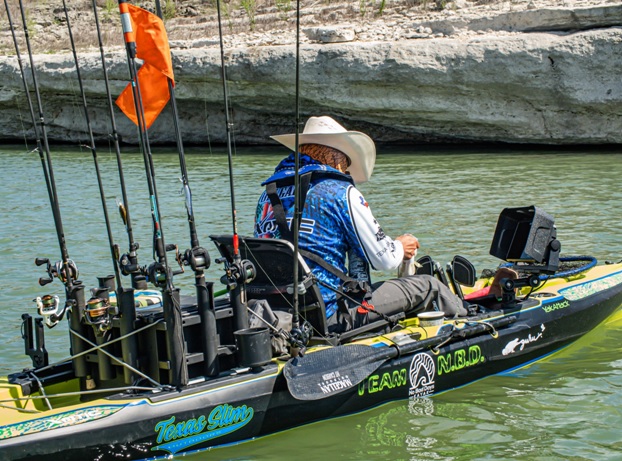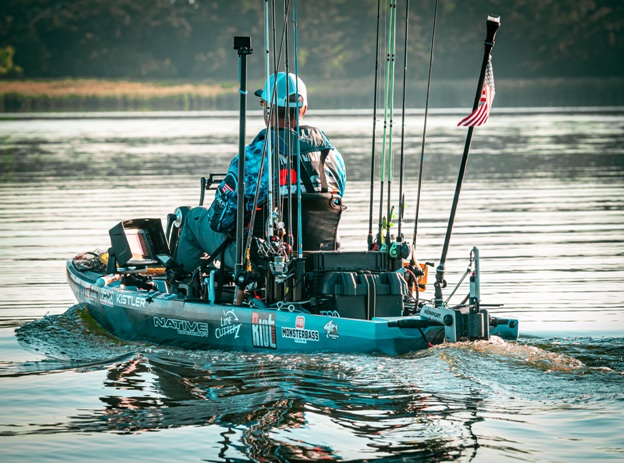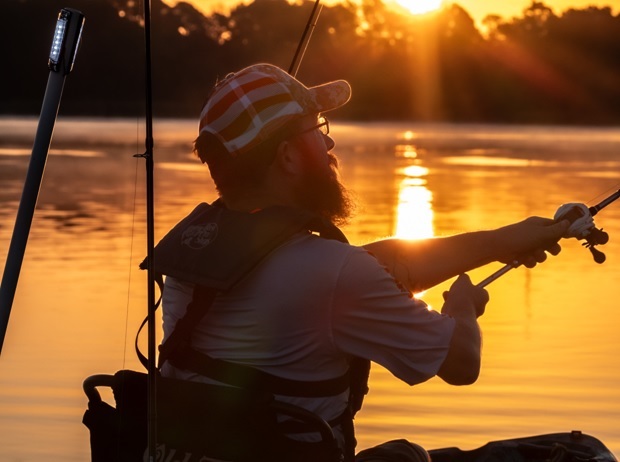Posted by Forrest on Aug 1st 2024
Getting Started Kayak Fishing: A Short Guide
Kayak fishing offers benefits that others on the shore, wading, or in larger aluminum and fiberglass vessels just can’t understand.
Like larger vessels, kayaks can free you from the shackles of the shore, but unlike larger motor-driven vessels, kayaks are fast, nimble, have shallower drafts, and are quieter. They’re the perfect stealth machines and can get you where other boats can’t go.
If this’ll be your first foray into the world of kayak fishing, here are a few things you’ll want to know.
Dress Appropriately
First, dress appropriately. If you’re fishing in the summer, you’ll want clothes that cover you and protect you from the sun, but which are light and quick-drying. Avoid dark colors if it will be sunny as these will absorb heat. Also, wear lightweight clothing; dress as if you might be swimming, just in case you get wet or fall in.
In the winter, it’s a different story. Layer and wear wool, which retains its insulative properties even when wet, and always wear a life vest - cold water is a killer.
Safety First
The most important aspect of safety on the water is to make sure you always wear a life vest. They may not be comfortable but they can save you if you take a spill and end up in the drink, especially if it’s cold and there are strong currents.
Beyond that, you should also carry a whistle or a signaling device like a horn so you can get the attention of other boaters or those on land if you need to.
Another important aspect of safety on the water is to carry and use a high-visibility safety flag. This will help other boaters see you, if you’re anchored or adrift in an area with a lot of traffic and your attention is more on casting than it is on the others on the water.
Scout Your Location
One of the most important tips we have for success while fishing is to know where you plan to fish. The atmospheric conditions, time of day, temperature of the water, and natural structure and topography will all influence where fish will be as well as how cooperative they will be.
Get the forecast and read a chart ahead of time. Know which spots you will want to target before you get on the water or else you will be blind casting - and that wastes time. You could get lucky, but having a good float plan and knowing what you will fish for, as well as with what baits and techniques, can afford better success.

Be Smart About Transport
Whether you’re transporting your fishing kayak via cartop or will be trailering it, make sure you have secured the vessel properly and drive cautiously. Always allow extra time for braking and if trailering, make wider turns. Fishing kayaks aren’t cheap and you want to make sure your rig, and everything in it, stays safe while in transport.
Launching and Loading
One tip for launching a kayak - don’t launch at a public ramp. Not only will there likely be traffic, which will make you feel rushed, but the concrete of the ramp will do a number on your kayak’s hull if you repeatedly launch and land there.
Find a more remote spot that’s sandy, gravelly, or muddy, and launch from there. You won’t need to compete for access and you also won’t damage your yak.
Another note on loading: make sure you have everything heavy tied down or secured in a hold/under a hatch before you launch. This will help prevent rolling and will make sure the yak handles more stably.
Watch Weather and Water
Being aware of the weather before you shove off is one of the most important aspects of a successful outing. Avoid days with high temperatures and humidity (if you can) as storms can crop up at a moment’s notice. Bring along a NOAA radio with you so can you check for updates throughout the day.
Water conditions can be just as important. You will want to avoid known hazards like dams and partially submerged structures (unless you’re targeting the latter, specifically) and you’ll also want to be able to read the tides and make sure you’re aware of areas with strong currents and other hazards.
Choose a Quality Fishing Kayak

You’ll also want to make sure you start with a quality fishing kayak. Many of the top brands are represented in our catalog, including:
- Old Town fishing kayaks
- Hobie kayaks
- Jackson kayaks
- NuCanoe kayaks
- HOODOO kayaks
- Viking kayaks
- Native Watersports kayaks
- Hammerhead kayaks
In general, look for a kayak that has rail tracks for accessories, is stable enough to stand in, has rod holders and tackle trays, and some tie down points. It also helps if the kayak is transducer ready so you can install a fishfinder.
Pedal or Paddle Power?
Most modern fishing kayaks come with pedal drives that power either a propeller or fins. These are fast, powerful, and will free your hands. However, they are not the best in very shallow or weedy, choked water.
In very shallow water or water with a lot of obstructions, a paddle-powered kayak like the NuCanoe Frontier 12 is a better option.
However, even if you opt for a pedal-powered kayak, make sure you bring along a paddle as a backup, and make sure it is tethered to the yak.
For more information, please see our previous post on pedal vs. paddle power.
The Kayak Fishing Essentials
It’s also important to remember to bring along everything you will need and to pack it wisely. You’ll want to have:
- A paddle (even if only as a backup)
- A PFD
- A whistle for signaling
- A safety flag
- Sunglasses (floating if possible)
- Sunscreen and bug spray
- First aid essentials
- A dry bag
- An anchor
- A flashlight and spare batteries (two flashlights are better than one)
- A compass and a chart
- Your phone and other personal effects
- An emergency beacon like an EPIRB (not a must but still good to have)
- Water and snacks
- A cooler, stringer, or creel bag
- A measuring tape
- A scale (not a must but nice to have)
- Any rods and tackle you’ll need to pursue your target species
Know Your Species
To be successful when kayak fishing, you must also know your target species. What you’ll need to fish for red drum will be quite different from what you’ll need to target panfish in a knee deep reservoir, or cats on a lake at night in midsummer.
For instance, if you’re chasing bluefish through inshore waters, you’ll want a lot of tough plugs and metals. These perform well and can stand up to that sort of abuse. If you’re fishing for spawning bass, you’ll want a lot of plastics.
This post simply doesn’t have room to go over the details of what tackle to bring based on species, but it is something very important that you need to consider. Make sure you do your research, consult local tackle shops, and be prepared with the tackle you need to be effective.
Be Patient

It’s equally important to remember that fishing, like any sport or outdoor pursuit, requires a good deal of experience and time afield. Don’t expect your first trip on the water to yield a limit full of whatever your target species is.
You could get lucky - we all do - but don’t get discouraged by a few outings that give you nothing but the skunk. It happens to everyone, including experienced anglers, from time to time.
Keep at it, keep researching, talk to other anglers, and switch up your technique if you can’t switch up your location. Sooner or later your rod will bend, and you’ll be just as hooked as the fish.
Time for a New Old Town, Hobie, Or Jackson Kayak?
No Bad Days Kayak is your source for the top fishing kayaks in the industry, as well as tackle and fishing kayak accessories. Shop a wide range of HOODOO, Hobie, NuCanoe, Old Town, and Jackson kayaks here and if you’re looking for additional information or a personalized recommendation, get in touch with us. We’d be happy to help you find the best vessel for your needs, or to answer any other questions you might have.

